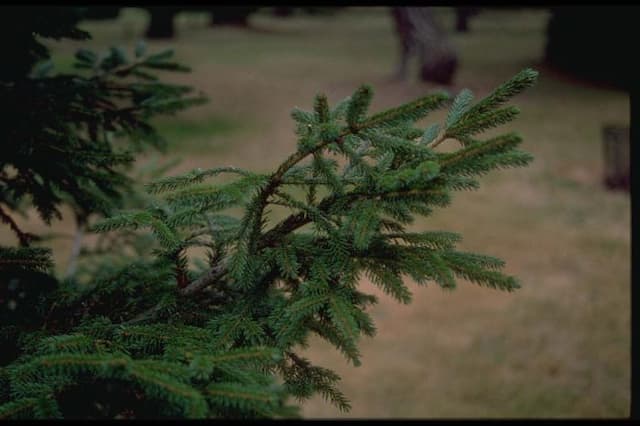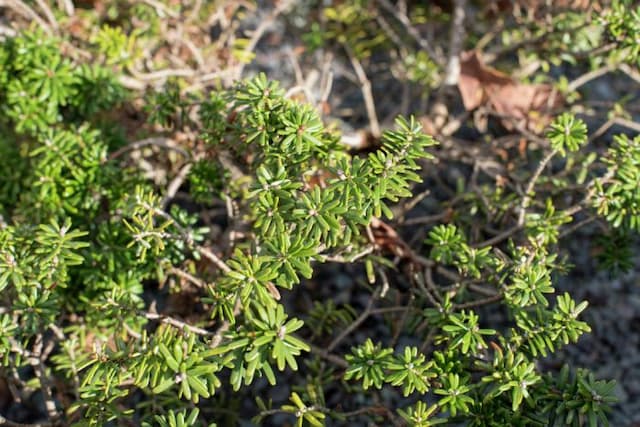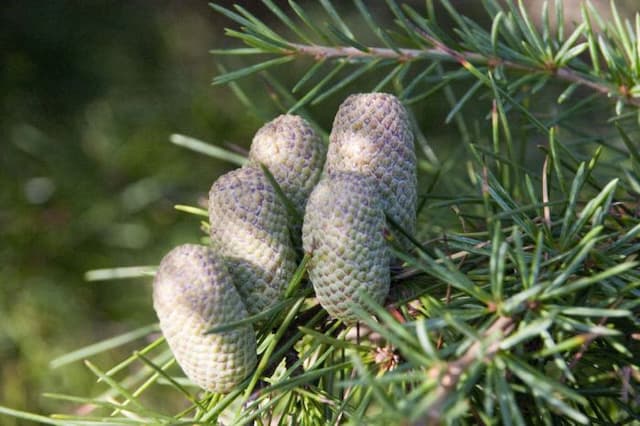Mugo Pine Pinus mugo 'Winter Sun'

ABOUT
The plant known as 'Winter Sun', a variety of mountain pine, is a coniferous evergreen that boasts dense, rich green foliage. Its needles are arranged in bundles, presenting a robust and bushy appearance. The branches are sturdy and grow in a symmetrical pattern, contributing to its compact and rounded shape. Seasonally, this mountain pine displays an array of golden-yellow tips on the needles, giving the impression that the plant is basking in the winter sunlight, hence its name 'Winter Sun'. This splash of color is most pronounced during the colder months, adding a cheerful brightness to otherwise drab winter landscapes. The cones of 'Winter Sun' are small and inconspicuous, blending in with the dense foliage. This plant's characteristics make it a favorite choice for gardeners looking to add year-round interest and color to their garden or landscape without the concern of overwhelming space.
About this plant
 Names
NamesFamily
Pinaceae
Synonyms
Dwarf Mountain Pine, Mugo Pine, Mountain Pine, Swiss Mountain Pine
Common names
Pinus mugo 'Winter Sun'.
 Toxicity
ToxicityTo humans
The Mugo Pine is generally considered non-toxic to humans. However, ingesting any part of the plant in large amounts could potentially cause gastrointestinal discomfort, such as nausea, vomiting, or diarrhea due to the fibrous and resinous nature of the plant material that is not typical human food.
To pets
The Mugo Pine is generally not toxic to pets. But as with humans, consumption of large quantities of plant material, needles, or sap could lead to gastrointestinal upset in some pets such as dogs or cats. This might manifest as vomiting or diarrhea, but serious poisoning is unlikely. Regular consumption should still be discouraged due to potential intestinal blockages or irritation.
 Characteristics
CharacteristicsLife cycle
Perennials
Foliage type
Evergreen
Color of leaves
Green
Height
6-10 feet (1.8-3 meters)
Spread
6-10 feet (1.8-3 meters)
Plant type
Shrub
Hardiness zones
2-8
Native area
Europe
Benefits
 General Benefits
General Benefits- Aesthetic Appeal: Pinus mugo 'Winter Sun', commonly known as dwarf mountain pine, adds visual interest to gardens with its compact shape and vibrant winter color.
- Low Maintenance: This variety of dwarf mountain pine requires minimal upkeep once established, ideal for gardeners seeking low-maintenance landscapes.
- Drought Tolerance: Dwarf mountain pine is tolerant of periods of dryness, making it suitable for xeriscaping and arid climate gardens.
- Cold Hardy: Winter Sun is capable of withstanding cold temperatures, making it a good choice for gardens in cooler climates.
- Erosion Control: The dense root system of dwarf mountain pine helps to stabilize soil and prevent erosion on slopes and hillsides.
- Wildlife Habitat: The dense foliage provides shelter for birds and other wildlife, enhancing the biodiversity of garden ecosystems.
- Evergreen Quality: As an evergreen shrub, Pinus mugo 'Winter Sun' retains its needles all year, providing consistent color and structure in the landscape.
- Windbreak: When planted in groups, dwarf mountain pine can act as a windbreak, protecting gardens from strong winds.
- Versatility in Landscape Design: The plant’s compact size and conical shape make it versatile for use in various landscape designs, including rock gardens, borders, and as a specimen plant.
 Medical Properties
Medical Properties- This plant is not used for medical purposes.
 Air-purifying Qualities
Air-purifying QualitiesThis plant is not specifically known for air purifying qualities.
 Other Uses
Other Uses- Landscape Photography Subjects: The compact and often picturesque form of mugo pine, especially the 'Winter Sun' cultivar, makes for an excellent subject in landscape photography, providing year-round visual interest.
- Model Train Scenery: Miniature scenes often use small, slow-growing plants like mugo pine to simulate full-size trees in model train setups, providing a realistic backdrop for the trains.
- Bonsai Specimens: Due to its slow growth and manageable size, mugo pine can be trained as bonsai, offering hobbyists a hardy and attractive option to shape and care for over many years.
- Windbreaks in Gardens: The dense foliage of mugo pine can serve as a windbreak in gardens, protecting more delicate plants from strong winds.
- Privacy Screening: When planted in rows or clusters, mugo pine can provide visual privacy for a yard or outdoor space while adding greenery.
- Outdoor Crafting Material: Branches and cones of mugo pine can be harvested to create natural decorations, wreaths, or centerpieces for rustic-themed crafts.
- Support for Climbing Plants: Gardeners can use the sturdy branches of mugo pine as a natural support structure for climbing plants or flowering vines.
- Erosion Control: The root system of mugo pine helps hold soil in place on slopes or embankments, thus contributing to erosion control in landscaped areas.
- Shade for Understory Plants: Mugo pine can provide dappled shade for shade-loving understory plants or ground covers that require protection from the full intensity of the sun.
- Artistic Inspiration: The unique shape and characteristics of mugo pine may inspire artists and designers as subjects that evoke the mountain landscapes where these plants are often found.
Interesting Facts
 Feng Shui
Feng ShuiThe Mugo Pine is not used in Feng Shui practice.
 Zodiac Sign Compitability
Zodiac Sign CompitabilityThe Mugo Pine is not used in astrology practice.
 Plant Symbolism
Plant Symbolism- Resilience and Strength: As a species of pine, Pinus mugo 'Winter Sun', commonly known as mugo pine, symbolizes resilience and strength due to its ability to thrive in harsh mountainous environments and resist the cold of winter.
- Longevity: Mugo pine, like many pines, can live for a very long time, making it a symbol for longevity and eternal life.
- Endurance: The capacity of mugo pine to endure through the seasons, particularly winter, signifies endurance and the ability to persist through challenges.
- Purity and Cleansing: Historically, pine needles have been associated with purification and are often used in cleansing rituals, symbolizing the plant's connection to purity.
 Water
WaterMugo Pine, as an adaptable coniferous shrub, generally requires moderate watering, making it essential to allow the soil to dry slightly between waterings. For young plants, watering once a week with approximately 2 gallons per session is beneficial for establishing a strong root system. Mature Mugo Pines are more drought-tolerant and may only need supplemental watering during extended dry spells, but ensure watering deeply to encourage roots to grow deeper into the soil. During the hot summer months, increasing the frequency to every 5-7 days may be necessary, whereas in cooler weather, reducing watering to every 2-3 weeks suffices. Always adjust watering based on rainfall, soil type, and seasonal changes to avoid overwatering, which could lead to root rot.
 Light
LightMugo Pine thrives in full sun conditions, which means it requires at least 6 hours of direct, unfiltered sunlight each day for optimal growth. It's best planted in a spot that receives ample morning sunlight and remains well-lit throughout the afternoon. Partial shade is also tolerated, but the intensity of the sun contributes to the plant's health and vigor, so aim for the sunniest location possible in the landscape.
 Temperature
TemperatureMugo Pine is quite hardy and can tolerate a wide range of temperatures, surviving in conditions as cold as -50°F, and enduring summer temperatures well above 100°F. The ideal temperature range for healthy growth is between 60°F and 70°F, but it adapts well to cooler and warmer conditions. Its resilience makes it an excellent choice for varying climates, withstanding frost and high heat with ease.
 Pruning
PruningMugo Pine typically requires minimal pruning, mostly to shape the plant or remove any damaged or diseased branches. The best time for pruning is late winter or early spring before new growth begins. Light pruning can be done annually, but major pruning should be done sparingly as Pines do not regenerate from old wood. Always use sharp, clean tools for pruning to ensure clean cuts and prevent disease transmission.
 Cleaning
CleaningAs needed
 Soil
SoilMugo Pine 'Winter Sun' thrives in well-draining soil with a pH ranging from 5.5 to 7.0. The best soil mix can comprise one-third peat moss, one-third garden loam, and one-third sharp sand to ensure proper drainage and aeration. Amend the soil with organic matter to enrich nutrient content and improve overall structure.
 Repotting
RepottingMugo Pine 'Winter Sun' grows slowly and typically doesn't require frequent repotting. It should be repotted every 2-4 years, or when it becomes root-bound. Spring is the best time to repot to minimize stress on the plant.
 Humidity & Misting
Humidity & MistingMugo Pine 'Winter Sun' is well adapted to outdoor conditions and does not require specific humidity levels to thrive. It can withstand a wide range of humidity levels typical of outdoor environments.
 Suitable locations
Suitable locationsIndoor
Place in bright light, avoid high heat, ensure pot has drainage.
Outdoor
Full sun, well-draining soil, allow for growth space.
Hardiness zone
2-8 USDA
 Life cycle
Life cycle'Winter Sun' Mugo Pine, a dwarf conifer variety, begins its life as a seed, often requiring a period of cold stratification to trigger germination. Upon sprouting, it develops a taproot and foliage in the form of needles. As a young seedling, it establishes a strong root system and begins to grow into a bushy, compact shape. During the juvenile phase, which can last several years, the 'Winter Sun' Mugo Pine experiences moderate growth and begins to form its characteristic dense, needle-covered branches. Once mature, it produces cones that release seeds, completing its reproductive cycle and potentially ensuring the propagation of new plants if conditions allow. 'Winter Sun' Mugo Pine has a long lifespan, often growing for several decades while requiring minimal maintenance in the right conditions.
 Propogation
PropogationPropogation time
Early Spring
Propogation: Pinus mugo 'Winter Sun', commonly known as Mountain Pine, is best propagated by seeds, which is the most popular method for this species. Seed collection usually takes place in autumn when the cones have matured. The cones should be stored in a warm, dry place to facilitate the release of the seeds. Once extracted, seeds can be sown in the spring after a period of cold stratification, which involves storing them at 33-41°F (0.5-5°C) for about 4 to 8 weeks to break dormancy. After stratification, the seeds are typically sown in well-draining soil in containers and placed in a cold frame or greenhouse until germination, which can take several weeks to months. It is important to keep the soil consistently moist but not waterlogged to prevent rot. Seedlings are then grown on for a couple of years before being transplanted to their final growing location.









